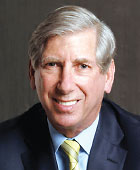On September 11, Elinore McCance-Katz, M.D., Ph.D., a psychiatrist specializing in addiction psychiatry with a background in academic medicine and public mental health, was sworn in by then Health and Human Services Secretary Tom Price as the first Assistant Secretary of Mental Health and Substance Use in the history of our country. Ellie brought her own copy of an antique Torah to the ceremony, which was witnessed by her friends and colleagues, including principals of APA. This occasion was important for many reasons, but none more so than it symbolized the return of psychiatry to its core mission of public mental health.
American psychiatry had strayed from this mission in the years after World War II into the 21st century. Most psychiatrists may not be aware of how this came about and why, but the origins of this story began with the creation of APA itself.
APA is actually the oldest medical specialty association in the United States. Of course, when it was created in 1844, it wasn’t called the American Psychiatric Association; rather it had the somewhat unflattering title of the Association of Medical Superintendents of American Institutions for the Insane. The name conferred the fact that psychiatrists managed institutions that warehoused “in however a humanely way” people with mental illness who could not reside in the community or function in society and for whom there was no treatment. While this reflected, at the time, a progressive movement in the evolution of mental health care, as mental illnesses became recognized as medical conditions rather than some type of moral, social, or legal deprivation, it moved psychiatrists away from the mainstream of medicine to the backwaters of scientific progress that advanced medicine over the 19th and early 20th centuries and the hinterlands of society.
In 1892 the name was changed to the American Medico-Psychological Association and then again in 1921 to its current name. Over this same period, Freud’s psychanalytic theory, and the talking cure that derived from it, had begun to transform the field of psychiatric medicine and mental health care. In addition to revolutionizing our understanding of the mind and human behavior, psychoanalytic theory and practice offered an alternative career path for psychiatrists that redirected their clinical efforts from people with severe mental illness to those with milder forms (extending to the “worried well”) and shifted their location from the asylum to the practitioner’s office. In general, psychiatrists found this to be a more intellectually appealing, therapeutically gratifying, and lucrative form of clinical endeavor.
However, as this became the dominant mode of practice, many psychiatrists withdrew from the public sector and abandoned its primary mission to care for people with schizophrenia, manic-depressive illness, and melancholic and psychotic depression. The contingent that remained engaged in “public mental health care” became known as “community psychiatrists.” By the 1970s, leadership of state mental health systems, hospitals, and community mental health centers were being transferred to nonphysician health care professionals. The schism that this produced was reflected in the uneasy alliance and ambivalent relationship between the principal agencies of the federal government responsible for mental illness and addiction research and services.
In 1973, the National Institute of Mental Health (NIMH), which had been created in 1946, was joined with the Health Services and Mental Health Administration to form the Alcohol, Drug Abuse, and Mental Health Administration (ADAMHA). However, like immiscible solutions, the medically minded researchers and socially oriented service administrators never really united and became factionalized and in some instances adversarial. As a result, in 1992, they were separated by Congress into three research institutes (NIMH, National Institute on Drug Abuse, and the National Institute on Alcohol Abuse and Alcoholism), which rejoined the National Institutes of Health, and a standalone agency, the Substance Abuse and Mental Health Services Administration (SAMHSA). This, in effect, ceded the services (as opposed to the research) component of mental health to non-medical health care disciplines. The last physician to hold a position of authority for mental health services in the federal government was Frederick Goodwin, M.D., who was a psychiatrist noted for his research in bipolar disorder; he headed ADAMHA just prior to its dissolution.
As a result, for over a quarter century, SAMHSA pursued an agenda that diverged from scientifically guided, evidence-based care and predominantly emphasized services and programs addressing social pathologies and promoting wellness. Over this period, the dissatisfactions of stakeholders and Congress grew, and they criticized SAMHSA for wasting money on services based on unproven theories and feel-good fads; alternatives to proven treatments that encourage patients to go off medications; wellness initiatives, including children’s books like A Day in the Park; brochures on “Making and Keeping Friends” and “Building Self-Esteem”; and workshops such as “Unleash the Beast” that promised to help attendees learn about mental illness by studying animal movements, instead of focusing efforts on programs proven to help people with severe mental illnesses.
This renegade policy, which marginalized scientific influence, was exemplified by the fact that SAMHSA had only one psychiatrist on its staff, in a subordinate position. In a 2014 congressional hearing, Congressman Tim Murphy questioned “how can the government’s number one mental health agency have only one psychiatrist on its staff of 574 employees?”
Several auspicious developments have recently occurred that could be game changing and signal psychiatry’s reengagement in public mental health. To mention just a few: Ann Sullivan, M.D., former APA Assembly speaker and director of psychiatry at Elmhurst Hospital in Queens, N.Y., is now the first psychiatrist to become commissioner of the New York State Office of Mental Health in 34 years. Working with her are Lloyd Sederer, M.D., Tom Smith, M.D., and Michael Compton, M.D., all accomplished community psychiatrists, as medical and associate medical directors, respectively. In addition, the last three people elected to serve as APA president have been public mental health–oriented psychiatrists (Maria Oquendo, M.D., Ph.D., Anita Everett, M.D., and Altha Stewart, M.D.). Joe Parks, M.D., the former commissioner of mental health for Missouri, was appointed medical director of the National Council for Behavioral Health, the largest organization of mental health providers in the United States. In anticipation of the mental health components of the 21st Century Cures Act being enacted, Anita Everett, M.D. and Steve Daviss, M.D., joined SAMHSA as medical director and senior medical advisor, respectively. All these and other such developments culminating in Ellie’s appointment, which entails operational authority over all federal government agencies supporting mental health care, first and foremost SAMHSA and its $3.5 billion budget. Her appointment also calls for a close working relationship with the NIH institutes and NIMH in particular, currently led by Josh Gordon, M.D., a psychiatric neuroscientist and graduate of Columbia University’s training program.
In a way, we have come full circle to rediscover our roots in mental health care. While it is gratifying and exciting to see this happening, the real challenge is to use our recommitment and assumption of leadership roles to fix the mental health care system and improve the quality and availability of care. This will not be easy, but we are better prepared and positioned to do so than ever before. ■

